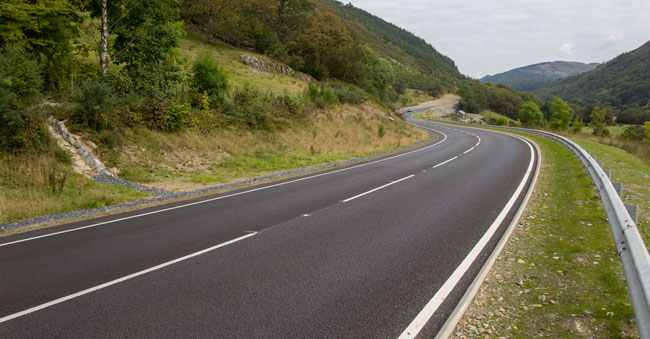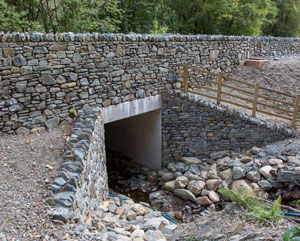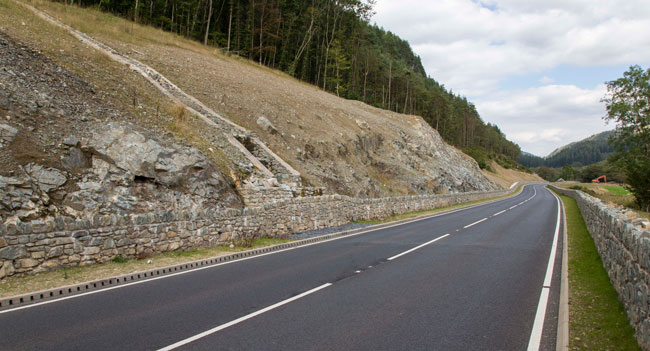A470 Gelligemlyn Highway Improvement SchemeWhole Team Award |
|
Project Team
Client: Welsh Government
Designer: YGC (Ymgynghoriaeth Gwynedd Consultancy)
Contractor: Balfour Beatty Construction Services UK
-------------------------------------------------------------------------------------------------------------------------------------------------------------------------------------
Project summary
The A470 Gelligemlyn Highway Improvement Scheme is located between Llanelltyd and Ganllwyd, Gwynedd, starting at the Gelligemlyn properties in the north and terminating at the entrance to Maes Mawr in the south. The main aim of the proposed scheme was to improve the safety of road users at this location.
The scheme involved upgrading and improving the safety of approximately 2km of the previously substandard A470(T) trunk road. The scheme generally followed the line of the previous road except for a short off-line section at the Gelligemlyn bends. The new carriageway width is 7.3m wide, with minimum 0.5m grass verges and a narrow 0.2m hardstrip. For environmental reasons, there were departures and relaxations in both horizontal alignment and visibility. All existing accesses and junctions were improved to provide greater safety.
The improvement is notable for the environmental sensitivity of the area within which it lies – not only the Snowdonia National Park, but also directly adjacent to Sites of Special Scientific Interest and Special Areas of Conservation designated under European legislation.

Challenges faced and Achievements
Ecology and Biodiversity
As discussed above the scheme is situated within a highly sensitive ecological landscape which meant that the design and construction programme had to be developed with the safeguarding of the rich habitats and protected species present adjacent to the site in mind. Ecological baseline surveys carried out to inform the EIA identified the following potential receptors within the study corridor:
- Meirionnydd Oakwoods and Bat Sites SAC/Ganllwyd SSSI
- Afon Eden - Cors Goch Trawsfynydd SAC/Afon Mawddach SSSI
- A vibrant otter population along the banks of the Afon Mawddach and its tributaries
- Two sizable bat roosts in the roof spaces of residential properties adjacent to the scheme
- Barn owl nesting site in an old stone building beside the scheme
- Active badger setts within close proximity to the area of works
- Stands of Japanese knotweed scattered throughout the site
The scheme design aimed to minimize impacts upon these features by: - Minimising the scheme footprint by applying variations to design standards |
 |
In light of the surroundings the Contractors Environmental Management Plan (CEMP) was created specifically to manage the potential effects of the scheme upon these ecological receptors and various measures were applied during the works which included:
- Management of the programme to ensure that key works were executed at times which did not disturb breeding bats or barn owls
- Site management to ensure sensitive areas could not be entered without necessary protection measures applied
- Watching brief for reptiles during soil stripping operations
- Translocation of valued lower plant species prior to start of works to suitable receptor areas beyond the influence of the works
- Measures to minimise risk of pollution incidents which could impact integrity of surrounding habitats
Measures to enhance the study area for wildlife include encouragement of BAP habitat colonization through natural regeneration along the extensive cutting slopes where plantation woodland had previously dominated, the provision of bird nesting features within the newly constructed walls and installation of barn owl nesting boxes next to suitable foraging habitat adjacent to the site.
Physical Resources Use & Management
Significant excavation into higher ground on the west side of the road was required to prevent encroachment upon the floodplain of the Afon Mawddach within the lower reaches of the valley, and as a consequence measures were implemented to manage the volume of various materials generated. The principle measure applied was to retain as much material as possible within the permanent works. Therefore a temporary processing plant was set up on site to generate suitable grades of material for inclusion within the earthworks and also stone for the construction of boundary walls and cladding of structures.
Despite the successful retention of materials on site a residual surplus of circa 35,000 cubic metres was still expected and therefore a waste strategy was developed between the contractor and overseeing organisation to manage this volume. A partnership was set up with Natural Resorces Wales (previously the Forestry Commission) with the aim of transferring surplus materials to a nearby mountain biking facility within their ownership. The project team assisted in developing proposals for the use of this material to construct and maintain pathways, create new car parking facilities and re-profiling areas within the visitors centre to allow the facility to better cater for the growing numbers of visitors experienced. The use of the material in this way provided numerous benefits including:
- preventing adverse environmental impact or impacts upon human health of material re-use
- minimising the carbon footprint of the scheme by transferring materials to a local site
- facilitating to the expansion of the mountain biking facility thereby contributing to the social and economical benefits generated by this site
Project Management
The CEMP was developed as the principal tool to manage the environmental impacts and opportunities associated with the scheme. The CEMP was built around the contractors accredited environmental management system and was adapted to focus on the main risks and opportunities applicable to the nature and location of the improvement following review of the Environmental Statement and Tender Documents. A register (ECR) was subsequently developed and included within the CEMP to collate all environmental commitments and the mechanisms employed to ensure their delivery with references to supporting documents such as method statements, licenses/permits and consultation responses. The ECR was updated on a regular basis to create an audit record on completion that all commitments had been discharged.
The effectiveness of the CEMP and it's positive influence upon the scheme was achieved through maximising the use of auditing and ensuring that achievements were critically reviewed and remedial actions promptly implemented, as well as high level audits an environmental site inspection was carried out by the site agent on a weekly basis. The findings of the auditing procedures informed a CEMP compliance report which identified any areas of non-compliance and identified procedural or operational remediation measures.
The delivery of the CEMP relied on buy-in and support from the construction team, which was achieved through the site induction, toolbox talks and bespoke training activities. The level of training was also subject to the auditing procedures described above and recorded in the compliance report.

To what extent did the use of CEEQUAL influence your project?
Environment and sustainability were very much headline issues for the scheme due to the sensitivity of the scheme corridor. The use of CEEQUAL further emphasised and structured the project approach to sustainability, and encouraged the project team to consider the opportunities and/or implications associated with different design and construction options throughout the duration of the contract.

